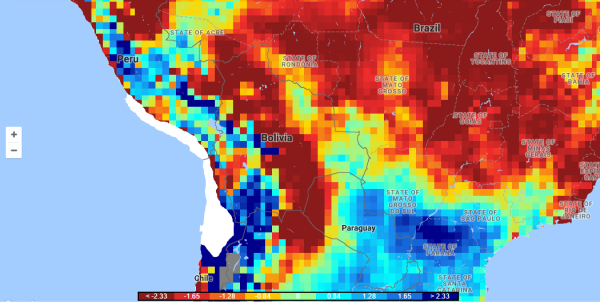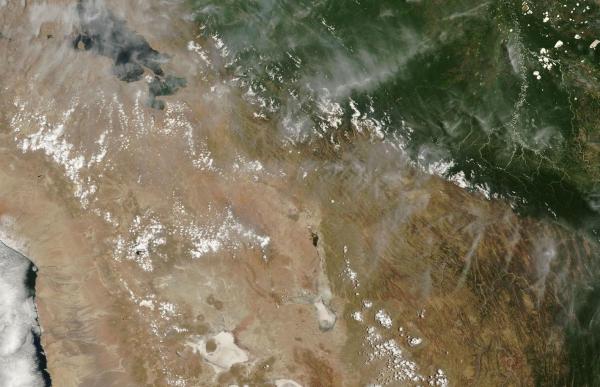Climate Change Has Left Bolivia Crippled by Drought
“Bolivians
have to be prepared for the worst.”
— President
Evo Morales.
*****
23
November, 2016
Like
many countries, Bolivia relies on its glaciers and large lakes to
supply water during the lean, dry times. But as Bolivia has heated
with the rest of the world, those key stores of frozen and liquid
water have dwindled and dried up. Warming has turned the country’s
second largest lake into a parched bed of hardening soil. This heat
has made the country’s largest lake a shadow of its former expanse
and depth. It has forced Bolivia’s glaciers into a full retreat up
the tips of its northern mountains — reducing
the key Chacaltaya glacier to naught.
Multiple reservoirs are now bone-dry. And, for hundreds of thousands
of people, the only source of drinking water is from trucked-in
shipments.
Drought
Emergency Declared for Bolivia
After
decades of worsening drought and following a strong 2014-2016 El
Nino, Bolivia has declared a state of emergency. 125,000
families are under severe water rationing —
receiving supplies only once every three days. The water allocation
for these families is only enough for drinking. No more. Hundreds of
thousands beyond this hardest hit group also suffer from some form of
water curtailment. Schools have been closed. Businesses shut
down.60,000
cattle have perished. 149 million dollars in damages have racked
up. And
across the country, protests have broken out.
The
city of La Paz, which is the seat of Bolivia’s government and home
to about 800,000 people (circa 2001) has seen its
three reservoirs almost completely dry up.
The primary water reservior — Ajuan Kota — is
at just 1 percent capacity.
Two smaller reserviors stand
at just 8 percent.
(Over
the past year, drought in Bolivia has become extreme — sparking
declarations of emergency and resulting in water rationing. It is the
most recent severe dry period of many to affect the state over the
past few decades. President
Morales has stated that climate change is the cause.
And the science, in large part, agrees with him. Image source: The
Global Drought Monitor.)
In
nearby El Alto, a city of 650,000 people (circa 2001), residents
are also suffering from water shortages. The
lack there has spurred unrest — with water officials briefly being
held hostage by desperate citizens.
As
emergency relief tankers wind through the streets and neighborhoods
of La Paz and El Alto, the government has established an emergency
water cabinet. Plans to build a more resilient system have been laid.
And foreign governments and companies have been asked for assistance.
But Bolivia’s larger problem stems from droughts that have been
made worse and worse by climate change. And it’s unclear whether
new infrastructure to manage water can deal with a situation that
increasingly removes the water altogether.
Dried
out Lakes, Dwindling Glaciers
Over
the years, worsening factors related to climate change have made
Bolivia vulnerable to any dry period that may come along. The added
effect of warming is that more rain has to fall to make up for the
resulting increased rate of evaporation. Meanwhile, glacial retreat
means that less
water melts and flows into streams and lakes during these hot, dry
periods.
In the end, this combined water loss creates a situation of drought
prevalence for the state. And when a dry period is set off by other
climate features — as happened with the strong El Nino that
occurred during 2014 to 2016 — droughts in Bolivia become
considerably more intense.
Ever
since the late 1980s, Bolivia
has been struggling through abnormal dry periods related to human
caused climate change.
Over time, these dry periods inflicted increasing water stress on the
state. And despite numerous efforts on the part of Bolivia, the
drought impacts have continued to worsen.
(In
this NASA satellite
shot of northern Bolivia taken on November 6, 2016, we find very thin
mountain snow and ice cover in upper center, a lake Titicaca that is
both now very low and filled with sand bars at upper left, and a
completely dried up lake Poopo at bottom-center. Bolivia relies on
these three sources of water. One is gone, and two more have been
greatly diminished. Scientists have found that global warming is
melting Bolivia’s glaciers and has increased evaporation rates by
as much as 200 percent near its key lakes. Image source: LANCE
MODIS.)
By
1994, added heat and loss of glaciers resulted in the country’s
second largest lake — Poopo — drying up. The lake recovered
somewhat in the late 1990s. But by early 2016, a lake that once
measured 90 x 32 kilometers at its widest points had again been
reduced to little more than a cracked bed littered with abandoned
fishing hulls. Scientists
researching the region found that the rate of evaporation in the area
of lake Poopo had been increased by 200 percent by global warming.
Bolivia’s
largest lake — Titicaca — is also under threat. From 2003 to
2010, the
lake is reported to have lost 500 square miles of surface water area.
During 2015 and 2016 drought near Titicaca intensified. In an act of
desperation, the government of Bolivia allocated
half a billion dollars to save the lake.
But despite this move, the massive reservoir has continued to shrink.
Now, the southern section of the lake is almost completely cut off by
a sand bar from the north.
In
the Andean mountains bordering Bolivia, temperatures
have been increasing by 0.6 degrees Celsius each decade.
This warming has forced the country’s glaciers into full retreat.
In one example, the Chacaltaya glacier, which
provided 30 percent of La Paz’s water supply,
had disappeared entirely by 2009. But the losses to glaciers overall
have been widespread and considerable — not just isolated to
Chacaltaya.
Intense
Drought Flares, With More to Come
By
December, rains are expected to return and provide some relief for
Bolivia. El Nino has faded and 2017 shouldn’t be as dry as 2015 or
2016. However, like many regions around the world, the Bolivian
highlands are in a multi-year period of drought. And the over-riding
factor causing these droughts is not the periodic El Nino, but the
longer-term trend of warming that is melting Bolivia’s glaciers and
increasing rates of evaporation across its lakes.
In
context, the current drought emergency has taken place as global
temperatures hit near 1.2 degrees Celsius hotter than 1880s averages.
Current and expected future burning of fossil fuels will continue to
warm the Earth and add worsening drought stress to places like
Bolivia. So this particular emergency water shortage is likely to be
just one of many to come. And only an intense effort to reduce fossil
fuel emissions can substantially slake the worsening situation for
Bolivia and for numerous other drought-affected regions around the
world.
Links:
Hat
tip to Colorado Bob
Hat
tip to ClimateHawk1
- Blazes have burnt 12,000 hectares, including five protected natural areas
- Endangered species under threat from fires that ‘took us by surprise’
Peru
has declared a state of emergency in seven districts in the north of
the country where forest fires have killed two, injured four and
burnt nearly 12,000 hectares (30,000 acres) of land, including five
protected natural areas.
Wildfires
have spread to 11 regions across the country, according to Peru’s
civil defence institute, in what scientists say may be the worst
drought in more than a decade.



No comments:
Post a Comment
Note: only a member of this blog may post a comment.